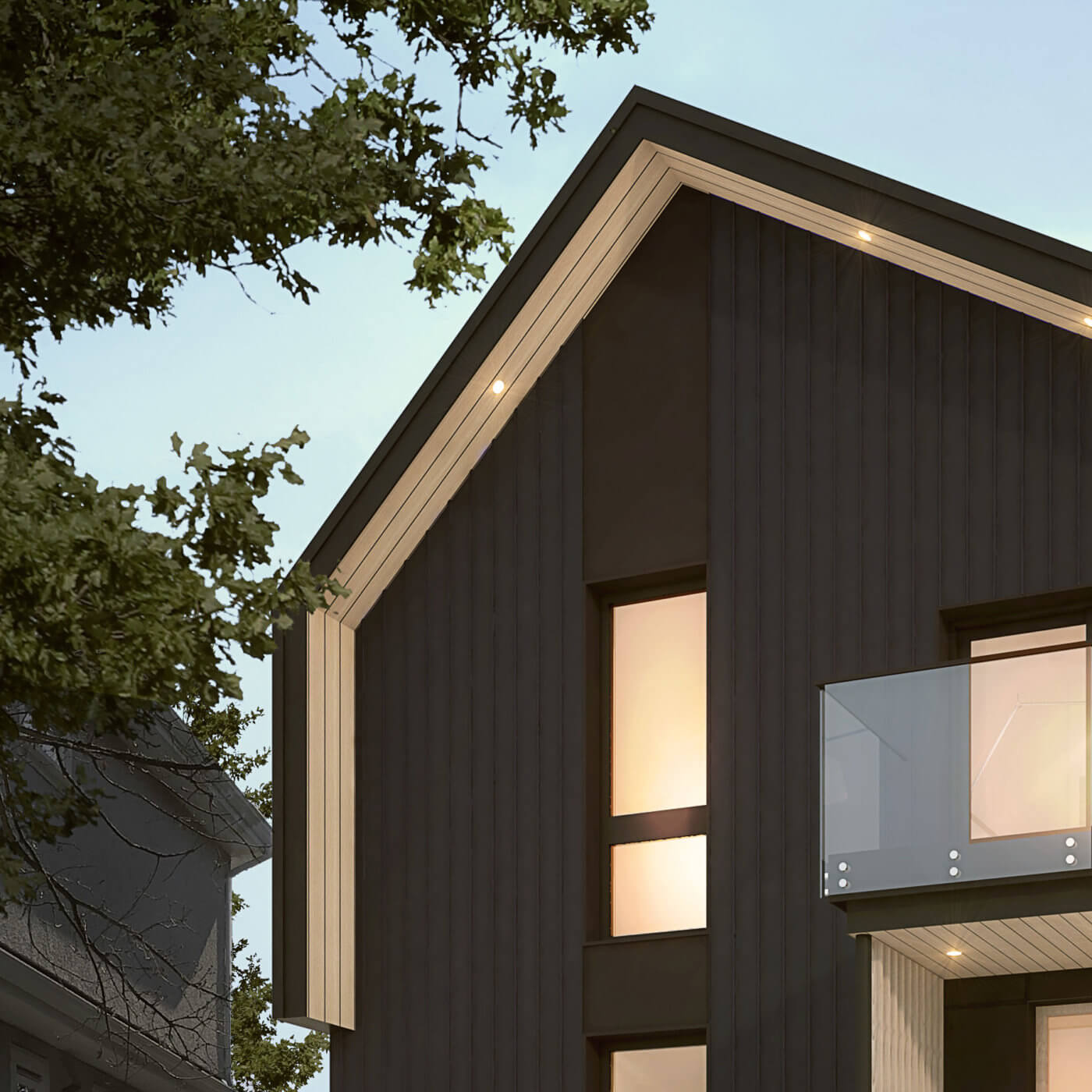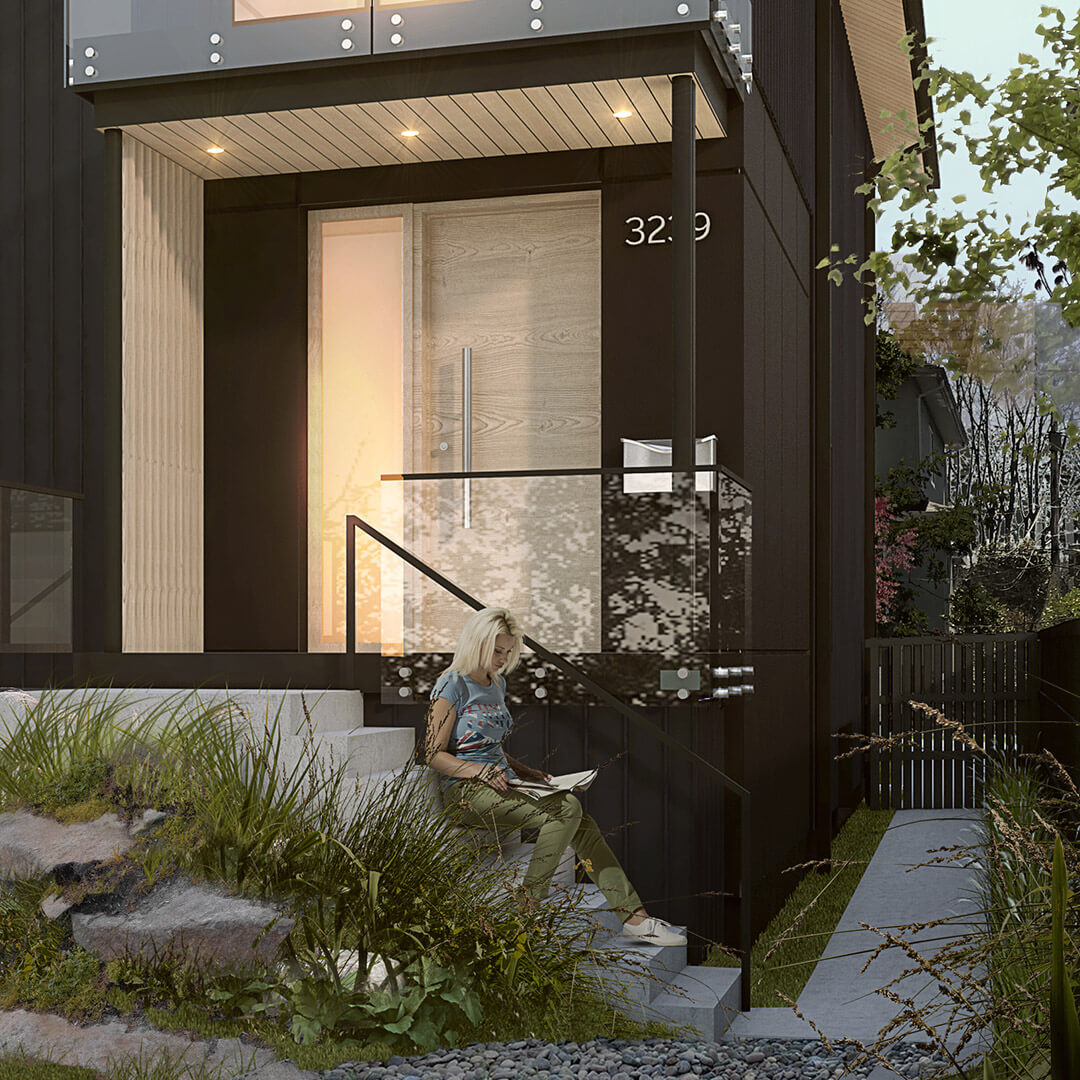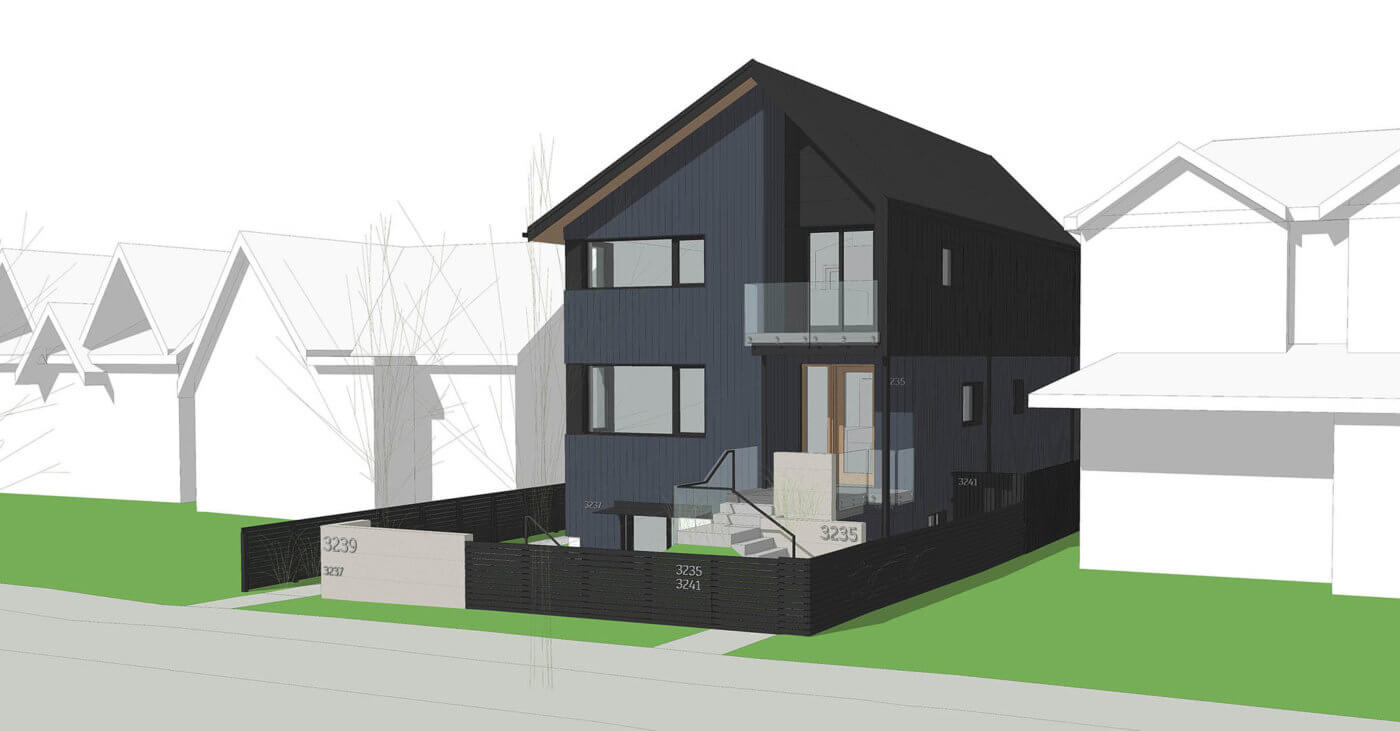
Bird’s Wing Passivhaus + Duplex
Vancouver
Custom Duplex
Located in the single-family RS-5 zone on the West Side of Vancouver, Bird’s Wing Passivhaus + marries Passive House thermal efficiency with spatial efficiency and a minimalist design.
The name “Bird’s Wing Passivhaus +” has several layers of meaning, describing the architecture, planning, and unique objectives of this custom duplex that includes two primary dwelling units as well as two flexible lock-off suites.
Read More
The planning of the duplex was an exercise in optimization of space, like a creative three-dimensional puzzle of interlocking pieces. Is there anything more complicated or as simple as a bird’s wing? Light and elegant, while at the same time, a complex and highly effective structure with many moving parts working together to expand, contract, and allow flight. Not unlike the Bird’s Wing Passivhaus +, in which the suites bend and fold around each other to maximize efficiency and provide evocative volumes within strict zoning regulations. Each unit has a full floor plate, open to the south at the front and with access to ample daylight and cross-ventilation through strategically placed side windows and framed views to the north. We opted for a stacked arrangement with one unit on the main floor and one on the upper, with front and back facing entry doors, respectively. This configuration strays from the design guidelines imposed by the City, but we were able to work with them on this relaxation to provide both units with equal access to large south facing windows and private entries.
A design objective for this high-performance duplex was to bring up to four households in “under its wing”, including a brother and sister, both accomplished professionals looking forward to their future retirement plans. It is a home designed to bring their immediate and extended families together, with communal outdoor living spaces for larger gatherings, while providing each with their own functional, and fully customized spaces within. The lock-off suites are within the Passive House thermal envelope, providing healthy and high-performance rental suites for the community while providing the owners with potential rental income and flexibility in how they use their home. They feature compact kitchens with all the amenities of a larger kitchen, shared or in-suite laundry, large windows, full bathrooms, and their own “front” door with access to shared outdoor space. All within the scale of a single-family home.
There are several additional objectives, or ‘+’s tackled in Bird’s Wing Passivhaus +.
+ Accessibility is a key consideration for ageing-in-place and informed our planning of a duplex which faced several accessibility related challenges including a compact footprint over three storeys in a zone requiring raised front porches and sunken basements. The entry design for each unit has incorporated a dedicated space and electrical rough-ins for a future outdoor lift to the entry porch, should one be required. Once at the level of the entry porch, there is easy access via a low-threshold front door to the interior. For the first floor unit, all of the primary living spaces are on that first floor for ease of access, including the primary bedroom, bath, kitchen, dining, living room, and oodles of functional storage. The upper unit has a single straight run stair from the entry, designed to accommodate a future interior chair lift, which goes from the entry to the upper floor. Again, once on that upper level, the primary bedroom, study, bathroom, kitchen, and all living spaces are on one level.
+ Adaptability of the home’s configuration is critical for affordability as well as ageing-in-place. Bird’s Wing Passivhaus + can expand or contract to suit changing needs over time, without the need for expensive renovations or permanent alterations. The interconnected lock-off suites on the lower level can provide rental income in retirement, or can be offered as a live-in suite to a caretaker. As needed, the owners can expand their primary units to incorporate the lock-off suites for additional space if, for example, their kids move back home, or to create a dedicated home office space, or to provide self-contained suites for visitors. Should they need less space, they can contract their space and move into the lower level lock-off suites, increasing their income stream significantly by renting out the upper two bedroom, two bath units. The typology is also appealing for a younger growing family. Instead of requiring a move to a larger home, or even a new neighborhood, when children arrive, the family can easily annex the basement suite to their main floor or top floor home. And later, perhaps as their children grow up and move out, the family needs less space and can rent the lock-off suite to a tenant, or perhaps to elderly parents. This chronological flexibility enables maximum density, where owners can adjust the number of households with ease.
+ Passive House Plus: This home exceeds classic Passive House requirements and is on-track for Passive House Plus certification with on-site generation of renewable energy thanks to a simple solar array over half of the upper roof. Passive House Plus is a newer standard created by PHI to acknowledge projects which produce approximately as much energy as the residents consume for an annual net-zero energy balance (reference: passipedia.org). On-site generation of renewable energy is an ideal complement to the efficiency of the Passive House Standard, where the heating demand is so low, that PV systems can be modest in size and therefore also in cost. Even with multiple suites in this compact duplex, thirty-three photovoltaic panels on the roof provide sufficient on-site collection of solar energy to offset the energy consumed by the households, when paired with our high-performance envelope and other features such as drain water heat recovery.
+ Holistic sustainability: Bird’s Wing looks beyond energy efficiency and Passive House and incorporates several additional sustainability measures for a healthy home. We took a low-embodied carbon approach to the house, and limited fossil fuel-based materials including petrochemicals, spray foam insulation (polyurethane) and rigid foam insulation (EPS and XPS), and vinyl. By having a sloped roof and using balconies instead of decks over living spaces, we were able to eliminate fossil fuel-based insulation (EPS, XPS, Polyiso) from the envelope above grade. We would have liked to eliminate them entirely, but at the moment, a viable alternate to EPS was not available for below grade insulation. All other insulation is mineral wool batt insulation or cellulose, both products with low-embodied energy that can be considered carbon sinks. Cellulose also has a high recycled content. Other sustainable measures include:
The house is vinyl free, as vinyl is red-listed on the Living Building Challenge red list as it is toxic, hard to recycle, and does not decompose. We did not use vinyl membranes, windows, nor flooring. Our windows and doors are fiberglass or locally sourced wood. We did not specify gas burning appliances in the duplex, and to ensure that fossil fuels are not used in the Passive House in the future, we are not running a gas line to the house.Siding and roofing is either steel (high recycled content, durable) or fiber cement (high recycled content, durable).Deconstruction was taken into consideration with new materials. We favoured materials that could easily be dismantled and reused, or recycled, like the mechanically fastened steel or fiber cement siding. We avoided adhesives wherever possible.Indoor air quality was taken into consideration when selecting paints, stains, and specifications for interior finishes, favouring non-toxic and low VOC options.Avoiding waste with a compact design that does not waste space.
+ Affordability + Density in Vancouver, where land comes at a premium, splitting the cost of land and construction between two families, while also creating income generating and sustainable rental suites, made the dream of building a custom and modern Passive House a reality for our clients. We capitalized on the City of Vancouver’s recently added floor area incentives which encourage Passive Houses and acknowledge the additional space occupied by the thick floor, roof, and wall assemblies of a Passive House. This additional 18% FSR for a duplex was a game-changer for our clients. It allowed an additional 610SF of floor area, and after deducting additional wall thickness, the net additional useable interior floor area provided was around 370SF. Our project went from a max allowable FSR of 3390SF to 40000SF. Sustainable incentives work!
Bird’s Wing Passivhaus + is a new housing typology that elegantly adjusts to the occupants’ needs for space and flexibility, without waste. The modern and minimalist design is tailored to the taste and lifestyle of each individual client and their shared commitment to sustainability and innovation. The result is a perfect balance in design, space, and nature.
#BirdsWingPassivhaus #BirdsWingPHPlusDuplex
Architecture: ONE SEED Architecture + Interiors
Interiors: ONE SEED Architecture + Interiors
Landscape: Green Elevations
Builder: Naikoon Contracting
CPHD: Kenneth Chan, JRG Building Engineering
Certifier: Tad Everhart ,CertiPHIers
Rendering: Estudio UCS






















